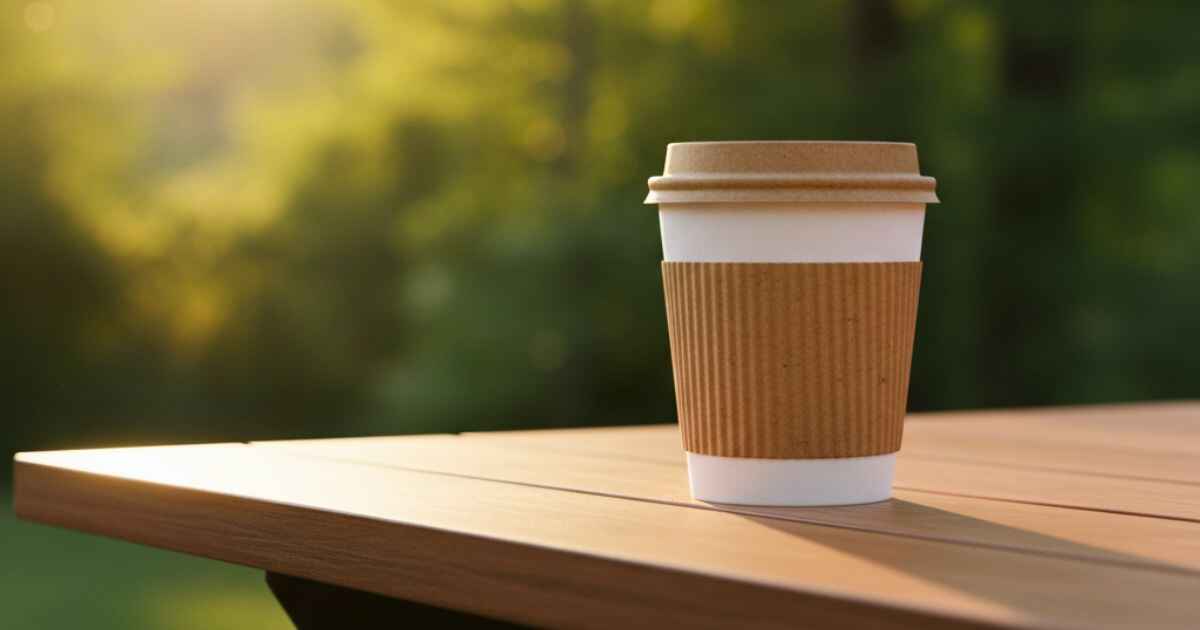Can a tiny lid made of cardboard really help the planet? At first, it sounds too small to matter. But this little tool, called a pappedeckel, is now part of a big eco story.
The word pappedeckel comes from Germany. “Pappe” means cardboard, and “Deckel” means lid. Put them together, and you get a cardboard lid. These simple round covers are placed on cups, jars, and food containers. They look plain, but they are doing important work. Instead of using plastic, which hurts nature, more shops are switching to these light paper lids.
Why is this a big deal? Every day, people drink coffee, tea, or juice in takeout cups. Most cups come with a plastic lid that gets tossed in the trash. Plastic stays in the earth for hundreds of years. A pappedeckel is different. It breaks down faster, it can often be recycled, and it is part of a green packaging solution that saves waste.
This tiny lid also helps businesses. It costs less to make, it can carry logos or art, and it makes customers feel good about choosing eco-friendly options.
So next time you sip your drink, think about the lid. It may look small, but it is part of a bigger change toward a cleaner, safer planet.
What Exactly Is Pappedeckel?
A pappedeckel may sound like a tricky word, but it is easy to understand. In German, “Pappe” means cardboard and “Deckel” means lid. Put the two words together, and you get a lid made of paperboard.
So, what is it really? A pappedeckel is a flat, round cover placed on top of cups, jars, or containers. Think of the lid on your hot cocoa cup or the cover on a small jar of jam. That is what a paper cup cover looks like. Instead of plastic, it is made from strong paper.
They come in many shapes and sizes. Most are circles, but some are made to fit square boxes or jars. A cardboard jar lid can keep food fresh, while a larger one may close off a bowl of soup for takeout. Shops and cafés often use them for coffee or tea cups.
The best part is that these covers are not just useful—they are better for the planet. A recyclable food cover can be reused in paper recycling instead of sitting in the trash like plastic. This makes them a smart choice for families, businesses, and even kids who care about clean oceans.
In short, pappedeckel are small lids with a big job. They keep drinks safe, make packaging lighter, and remind us that little changes can help the earth.
You May Also Like: Best GameCube Games List: Timeless Nintendo Hits to Play
History and Evolution
The story of pappedeckel begins in Germany. For many years, cafés and food shops used plastic lids for drinks and containers. But people started to notice how much plastic waste was piling up. It stayed in landfills, rivers, and oceans. Something had to change.
This is where eco packaging innovation played a role. Around the early 2000s, more businesses began to look at cardboard as a safer option. A lid made of paperboard could do the same job as plastic but without lasting forever in the ground. At first, they were very simple—just plain round lids.
Over time, they grew fancier. Companies saw them as a chance to print logos, messages, or even art. This made the lids more than just covers. They became tiny billboards that showed a shop’s eco values.
The rise of plastic bans in Europe made change faster. Laws pushed businesses to find safer materials. Customers also wanted choices that were kinder to nature. A sustainable lid alternative like pappedeckel fit both needs.
Now, these lids are used in cafés, takeout shops, and even at home. What started as a plain cardboard cover is now part of a global eco movement. And the story is still growing as more people learn about them.
Materials and How It’s Made
Pappedeckel may look simple, but making one takes care and planning. The main material is paperboard, a thick type of paper that is strong but light. This material is safe for food, which makes it perfect for a paperboard sealing lid.
To make it even better, many lids have a thin eco-friendly coating. This stops drinks like hot coffee from soaking through. Unlike plastic layers, these coatings are often made to break down in nature. That means the whole lid can still be composted or recycled.
Another part is the ink. Companies use food-safe ink to print logos or designs. These inks are safe if they touch food or drinks. This is part of why these lids are trusted in cafés and shops.
If we compare them to plastic lids, the difference is clear. Plastic is strong but takes hundreds of years to go away. A biodegradable container cover is not only safer for the earth but also easier to recycle.
Design also matters. An eco lid design can fit tightly, stop spills, and still look nice. Some lids are smooth and simple. Others have space for a straw or sipping hole. This shows how even a small lid can mix science, safety, and style.
Pappedeckel may be tiny, but the way they are made proves that smart choices in design can protect both people and the planet.
Also Read Our Latest Post: Mal Hill Explained: From Lauryn Hill’s Roots to Real Estate
Real-Life Uses Across Industries
A pappedeckel may look small, but it does many useful jobs. Let’s see how different places use it.
Food & Beverage
Go to a coffee shop, and you will see pappedeckel on hot drinks. They work as a sustainable coffee lid instead of plastic ones. Fast-food shops also use them for cold sodas, soups, and shakes. Bakeries use them to close boxes so cakes and cookies stay fresh. These light lids help shops serve food and drinks while making less waste.
Cosmetics & Jars
Pappedeckel is not only for food. Beauty brands use them too. A cream jar or serum bottle can be closed with an eco-friendly cup cover made from paperboard. This keeps the package clean without using plastic foil. Shoppers like that their creams and lotions come in safe, nature-friendly packages.
DIY & Crafts
People who love crafts also use these lids in fun ways. A cardboard beverage cover can become a gift topper, a party tag, or a small decoration. Kids use them in art projects at school. Adults use them for candles, jam jars, or handmade gifts. This shows that the lid is not just useful but also creative.
Why It Matters
Most of the time, we don’t think about a simple lid. But every eco crafts packaging cover saves plastic. It also shows us a new way to live greener. From coffee shops to craft tables, pappedeckel proves that small things can make a big change.
Benefits: Why Businesses Love It
Why are so many companies using pappedeckel? The answer is simple: it helps their work and makes them look good.
First, it saves money. A recyclable drink lid costs less than a plastic lid. It is light, so boxes full of them are cheaper to ship. This helps cafés and shops spend less on transport.
Second, the lid is also free ad space. Shops can print names, logos, or even fun art on top. This is called eco branding on lids. Every cup becomes a little ad in a customer’s hand. People notice and remember the brand.
Third, it shows a company cares. Today, many buyers want eco choices. A lightweight packaging lid proves the shop is trying to cut waste. Customers feel happy about picking that place, and this builds trust.
Last, the lids help with rules about plastic bans. A sustainable branding lid keeps shops safe from new laws. They don’t have to worry about plastic being banned because they already use better lids.
So, for businesses, pappedeckel is more than a lid. It saves money, helps with ads, builds trust, and protects the planet.
Problems and Limitations (The Hidden Truth)
Pappedeckel sounds great, but it also has some problems. People should know the limits before using it everywhere.
The first problem is water and heat. A zero waste packaging lid can get soft if the coating is too thin. Hot soup or oily food may leak. To stop this, makers need to add a stronger layer.
The second problem is cost. A biodegradable takeaway lid with extra coating costs more than plain cardboard. Small cafés may find this harder to afford.
The third problem is awareness. Not everyone knows about pappedeckel. In some countries, people still trust plastic more. A disposable eco cover may look weak, even if it works well. Shops need time to teach customers.
The last problem is food type. A recyclable product lid is best for drinks and quick snacks. But it is not always good for wet sauces, frozen food, or items stored for many weeks.
So, while pappedeckel is a smart step for the planet, it is not perfect yet. We need better coatings, lower costs, and more awareness around the world. With these changes, the lid can be used more widely.
Environmental Impact: The Science
Plastic lids and paper lids are very different. A recyclable cardboard cover is much safer for the earth than plastic.
Decomposition Time
Plastic lids can stay in landfills for hundreds of years. They break into tiny bits called microplastics. These hurt fish, soil, and even food chains. A compostable cup cover made from paperboard breaks down in just a few months. Some even turn into compost at home.
Recycling
It is also easier to recycle. A circular economy packaging lid goes into paper recycling. It is mixed with water, made into pulp, and turned into new paper. This way, materials get reused again and again.
Bigger Picture
Choosing a compost-friendly packaging lid means less plastic in the ocean, cleaner beaches, and safer food. One lid may not seem like much, but billions of them together make a huge difference.
To clearly see the difference, here’s a quick side-by-side comparison of plastic lids and pappedeckel.
🌍 Plastic vs Pappedeckel: Which Lid Wins for the Planet?
Plastic Lid
- Made From: Petroleum plastic
- Biodegrades In: 400–500 years
- Recyclable: Rarely
- Impact: Microplastics, long-lasting waste
Pappedeckel
- Made From: Cardboard
- Biodegrades In: 2–6 months
- Recyclable: Yes
- Impact: Low footprint, compostable
This simple chart shows why even a tiny change in packaging choice can have a massive impact on the planet.
Here’s a simple table to compare:
| Lid Type | Made From | Biodegrades In | Recyclable? | Impact on Planet |
|---|---|---|---|---|
| Plastic Lid | Petroleum plastic | 400–500 years | Rarely | Stays long, creates microplastics |
| Foil Lid | Aluminum foil | Does not biodegrade | Sometimes | Uses heavy mining, high energy |
| Pappedeckel | Cardboard | 2–6 months | Yes | Light impact, compostable |
This table shows why the choice matters. Cardboard lids cut waste and give the planet a chance to heal.
Consumer View: Safe or Not?
When people first hear about pappedeckel, they often ask: is cardboard safe for food? The short answer is yes, but let’s look closer.
A recyclable jar cover is made from paperboard. This material is tested to make sure it does not harm drinks or snacks. Cafés, bakeries, and factories follow food safety rules when using these lids. That means the cardboard is clean, safe, and fit for direct contact with food.
Still, some people worry about coatings. To stop leaks, makers sometimes add a thin layer on the lid. In the past, these coatings were plastic. But now, many brands use eco-safe layers that can break down in nature. These coatings keep hot coffee or oily soup from soaking through without adding danger.
Another question is about the ink. When shops print logos on an eco-conscious lid design, they use food-safe ink. This ink does not rub off into drinks or jars. That makes it safe for customers of all ages.
Compared to plastic, paper lids also feel cleaner. Plastic lids may carry germs if reused, but cardboard is often single-use and then recycled. A recyclable coffee cover goes into the paper bin, helping to cut waste while keeping hygiene in check.
So, are they safe? Yes. They meet health rules, use safe inks, and are easy to recycle. For families, cafés, and eco-shoppers, these lids are both practical and safe to trust.
Global Adoption and Case Studies
The story of pappedeckel is not just German anymore. Today, countries and companies around the world use them. Let’s see how.
Food & Drinks
In Europe, cafés in cities like Berlin, Paris, and Milan serve hot drinks with an eco food service lid. Coffee shops show customers they care about waste by choosing paper over plastic. Juice bars also use them for smoothies and cold teas. Bakeries often close small jam jars or cake boxes with these lids.
Cosmetics
Beauty brands are also joining in. A sustainable food container lid works just as well on cream jars or lotion bottles. It gives the product a clean look while cutting out plastic wraps. This trend is growing in Japan, South Korea, and the U.S., where buyers want packaging that feels natural.
Laws & Rules
In India and parts of Africa, governments are starting to ban single-use plastics. This has opened the door for pappedeckel. Shops and food stalls now look for safer, cheaper, and greener lids. A green coffee lid solution is not only eco-friendly but also fits local laws.
Consumer Demand
People worldwide want choices that protect the planet. Surveys show buyers often pick shops that use green packaging. Families in Canada and Australia prefer cafés with recyclable lids. Even in small towns, local juice stalls are making the switch.
From Europe to Asia and beyond, pappedeckel is part of a quiet but strong movement. Each case shows that a tiny lid can help meet new laws, please customers, and push us closer to a world with less plastic waste.
Future Trends in Packaging
What will happen next with pappedeckel? Experts say the future is bright — and creative.
One big idea is smart lids. Imagine scanning your coffee cover with your phone to see where the cup was made or how to recycle it. Some tests even show lids with QR codes that link to fun games or eco tips. This makes every sustainable packaging cover more than just a lid.
Another trend is stronger coatings. Today’s cardboard lids sometimes leak with hot soups or oils. New research is making better layers from plants like corn or sugarcane. These coatings are safe, compostable, and keep drinks hot without spills. Soon, your eco lid for hot drinks will be as strong as plastic but still vanish in compost bins.
Branding will also change. Shops want designs that stand out. Future lids may glow in color, carry raised prints, or show art that tells a story. Every cup will become a tiny ad or art piece while still being earth-friendly.
Finally, global laws will push growth. More bans on plastic will make businesses switch faster. A recyclable takeaway cover will not be rare — it will be the normal choice in cafés and stores everywhere.
So the future of pappedeckel is smart, safe, and stylish. It will keep drinks covered while also teaching us how small changes can lead to a cleaner planet.
Pros and Cons (Simple Summary)
Every product has good and bad sides. A pappedeckel is no different. Let’s look at the pros and cons in a simple way.
Pros
- A green alternative to plastic lids. It breaks down faster and makes less waste.
- Easy to recycle. A recyclable paper lid can go into paper bins and come back as new paper.
- Safe for food and drinks.
- Lighter to ship, so it saves money.
- Can be printed with logos or designs for branding.
Cons
- May get soft with very hot or oily food if coating is weak.
- Sometimes costs more than plastic lids.
- Not yet common in every country, so people may not know about it.
- Works best for short-term storage, not for frozen or long-term packed food.
Pros vs Cons of Cardboard Lids
| Pros | Cons |
|---|---|
| Eco-friendly, less waste | Can soften with heat/oil |
| Recyclable and safe | May cost more |
| Good for branding | Not known everywhere |
| Light and easy to ship | Not always for long storage |
This balanced view helps us see the truth: the lid is not perfect, but it is still a smart choice for people who want less plastic in their daily life.
Buying Guide for Consumers & Businesses
If you want to try pappedeckel, here’s a simple guide.
1. Size
Check the size before buying. Small lids fit jam jars, while bigger ones fit coffee cups.
2. Coating
Pick the right coating. For hot soup or tea, choose lids with stronger eco layers. For dry snacks, plain cardboard is enough.
3. Branding
Many companies like custom prints. A smart eco lid design can carry a logo, brand color, or even eco messages. This makes packaging look professional and caring.
4. Certifications
Look for safe labels. Food-safe inks and compostable signs show that the lid is tested and safe for use.
5. Where to Buy
- Local packaging suppliers.
- Online eco-shops that sell in bulk.
- Wholesale stores for cafés and bakeries.
A recyclable sealing solution is often sold in packs, so buying more at once saves money.
Tip for Businesses
Start small. Order a test batch to see how customers like them. Then move to larger orders.
With this simple guide, families and cafés can pick lids that are safe, stylish, and better for the planet.
Conclusion
A pappedeckel may be small, but it has a big story. It started in Germany, and now it is used worldwide. People like it because it cuts waste, keeps food safe, and offers a new way to package drinks and snacks.
When we pick an environmentally friendly lid, we stop using plastic that harms nature. These lids can break down and be recycled. This small choice helps keep our oceans, rivers, and cities clean.
For families, it means safer cups. For cafés, it means better branding and lower costs. For the planet, it means cleaner land and water.
The next time you sip coffee or open a jar, check the lid. That tiny cover may be your part in a bigger eco movement.
Change often starts small — and here, it starts with a lid. Let’s choose smart and make tomorrow greener.
FAQs Section
Q1: What is a pappedeckel made of?
A pappedeckel is made from paperboard. It may also have a thin eco coating to stop leaks. Unlike plastic, this biodegradable beverage lid breaks down in nature.
Q2: Is it safe for hot drinks?
Yes. A renewable packaging lid is tested for food safety. It can handle coffee, tea, or soup. Some lids even have special coatings to stay strong with heat.
Q3: Can it fully replace plastic lids?
Not yet in every case. A disposable cardboard lid works well for short-term use. But very oily or long-term storage items may still need stronger covers. More research is helping to close this gap.
Q4: How do you recycle it?
Most eco packaging lids can go into paper recycling. They are mixed with water, turned into pulp, and made into new paper. Some lids are also compostable, which means they can break down in garden compost.
Q5: Where can I buy eco lids?
You can buy them from:
- Local packaging suppliers
- Online eco-shops
- Wholesale food service stores
Look for safe labels and bulk packs for better prices.
Disclaimer: This article is for general informational purposes only. It does not replace professional packaging, safety, or environmental advice. Readers and businesses should check local recycling guidelines and regulations before choosing packaging solutions.

What we have to know about the cryptocurrencies

Jonathan Taylor Thomas Wife Natalie Wright: The Truth Behind His Private Life

Tarayummy Height & Body Stats: Facts About Her Real Size!

How to Use TheBoringMagazine Contact Safely and Avoid Scams

Joseph Quinn is a writer and digital creator best known as the founder of FreakBobTime. With years of blogging experience, he blends technology, culture, and internet humor into unique stories and creative experiments. Through his work, Joseph brings back the playful, weird side of the web while making content that connects with readers worldwide.






1 thought on “Why Pappedeckel Beats Plastic: The Green Future of Cups”